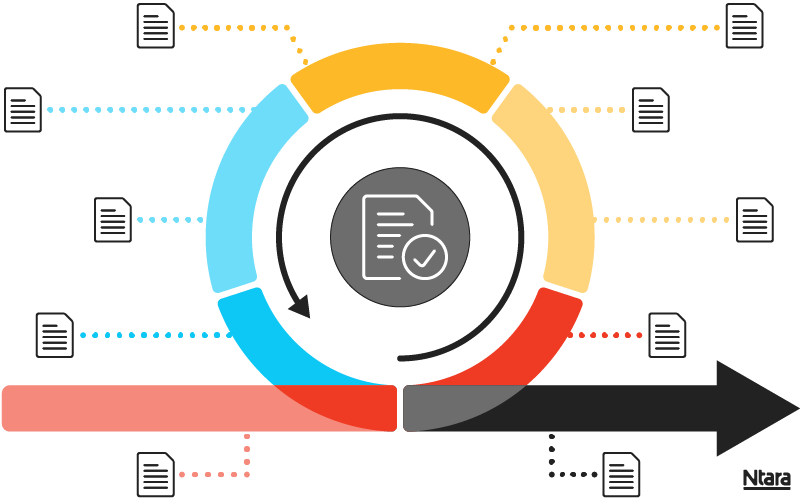In digital commerce, documentation is often lumped into a single bucket. But not all documentation serves the same purpose. At Ntara, we distinguish between two critical types: technical documentation and user documentation. Both are essential, but they serve different audiences, solve different problems, and deliver different business value.

Understanding the difference can help CIOs build more resilient and scalable systems, empowering their teams to move faster with fewer errors.
Type 1: Technical documentation (a.k.a. “under the hood”)
This is the documentation that developers, architects, and system integrators rely on. It includes feature specifications, API references, integration logic, data models, configuration decisions, and more.
Think of technical documentation as an instruction guide for how we’ll develop your solution. It covers how it will work and what the expected functionality is.
Here’s how it delivers value across the development lifecycle:

Onboarding new developers
Get new developers up-to-speed faster with clear documentation. It gives them the context for how systems are built and a reference point for expected functionality. Without this type of documentation, onboarding slows down productivity and increases the risk of missteps for the new hire.

Debugging issues
Documentation is the first line of defense when something breaks. It should be the reference point for how each system in your tech stack was designed to behave. This helps developers isolate the root cause of an issue quickly. Without documentation, teams must interpret these things on their own, which can lead to misdiagnosis, wasted time, and recurring problems.

Scaling systems
Documentation tracks the functionality of new features and integrations over time, without disrupting what already works. It is the blueprint for consistent development practices. This makes it easier to scale across teams, technologies, and business units. Without a foundation of clear documentation, growth typically results in technical debt.

Maintaining consistency across teams
In multi-team environments, documentation holds everything together. It ensures that everyone, from developers to business analysts, works from the same playbook. This reduces discrepancies and ensures that features are built, tested, and deployed according to plan. Without the right documentation, small misalignments can snowball into major inefficiencies.
Without technical documentation, teams lack the context needed to understand how systems are intended to function. Avoid misunderstandings, misalignment, and costly rework with proper technical documentation.
Type 2: User documentation (a.k.a. “how-to guides”)
This documentation is for the people who use your systems day-to-day, like marketers or merchandisers. It includes step-by-step guides, admin panel instructions, definitions, and workflow overviews. All user documentation should support specific use cases, such as creating a blog or setting up a new service page.
These are for them to remember how to do configurable things, like how to create a blog or set up a new service page.
This documentation is critical for:

Reducing support tickets
Clear user documentation empowers non-technical team members to complete routine tasks. Answer common questions in your user documentation to reduce support tickets, and free up your technical teams to focus on higher-value work.

Empowering non-technical users
Well-crafted user documentation gives non-technical users the confidence and clarity to do it themselves. Whether that’s managing content, configuring features, or executing tasks independently, it drives value. Reducing reliance on IT fosters autonomy and accelerates day-to-day operations.

Ensuring consistent content quality
Users who know the right way to create, manage, and publish content will follow standardized process and formatting guidelines. This consistency reduces errors, which strengthens your brand and creates a uniform experience across all touchpoints.

Supporting governance and compliance
User documentation is a clear record of how systems are configured and operated. This is critical for audits, regulatory reviews, and internal governance. User documentation ensures processes are followed and decision-making is traceable over time.
Why both technical and user documentation matter
Too often, organizations invest in one type of documentation and neglect the other. But both are essential for long-term success.
Without technical documentation, your system becomes a black box. Without user documentation, your team becomes dependent on your technical team for every change.
Proper documentation creates a self-sustaining ecosystem that empowers teams to build, scale, and adapt with confidence.
Business value: What CIOs gain from documentation
Investing in documentation isn’t just about process. It’s about performance. For CIOs leading digital commerce initiatives, it’s a foundational tool that drives operational efficiency and supports growth. Here are four key business outcomes that strong documentation practices enable—and the risks businesses face when they’re missing.
1. Faster onboarding
When someone joins the team, documentation is the roadmap to understanding the systems they’ll work with. Technical documentation provides detailed insight into how features are built, how systems are integrated, and what logic drives functionality. User documentation, on the other hand, helps non-technical team members quickly learn how to manage content, configure workflows, and execute tasks without much support.
Without this foundation, onboarding can be slow and prone to errors. It drains time from senior team members and delays productivity for new hires.
2. Reduced risk
Documentation should be a single source of truth for global teams. It specifies which decisions were made and why. It shows how configurations and processes should work. And anytime issues arise, teams can use documentation to resolve them.
Without documentation, businesses must rely on institutional memory. What if your subject matter expert wins the lottery tomorrow? Documentation is insurance. It reduces the risk of rework and project delays.
3. Increased agility
Well-documented systems empower teams to make changes quickly and confidently. Developers have the context they need without having to ask. Content teams can launch new campaigns without waiting on IT. This is especially critical in fast-moving industries where time to market is a competitive advantage.
4. Better governance
Documentation makes processes transparent and repeatable. It enables an audit trail and ensures compliance with all standards. And it provides a clear record of how and why decisions were made. For businesses operating across multiple business units or regions, this is essential for maintaining quality and accountability.
Without documentation, governance is reactive rather than proactive. Organizations can struggle to scale their systems and processes in a controlled, compliant way.
Ntara’s approach to documentation
At Ntara, documentation isn’t a static deliverable. It’s a living, collaborative process that evolves alongside the project. We embed documentation into every phase of our engagements, from discovery through deployment and beyond. This ensures that it reflects what was built and why it was built (or adjusted) a specific way.

We use structured templates to capture requirements and invite stakeholders to participate as needed. This ensures alignment across teams and reduces the risk of misinterpretation.
We integrate documentation tightly with project management tools. Every user story, feature ticket, and configuration decision, should inform the documentation. This way, each change is traceable and contextualized. And as systems evolve, we update them.
Our approach to documentation is all about enabling teams to move faster, with greater confidence, and less risk.
Conclusion: Documentation is a dual investment
Documentation isn’t just insurance—it’s a foundation for scale. It enables teams to move faster, make smarter decisions, and deliver better experiences. It’s a strategic enabler.
When technical and user documentation are implemented effectively, the ROI is evident. Faster onboarding. Increased agility. Stronger governance. All creating a more consistent user experience with your products.
At Ntara, we embed documentation into every phase of the process. And we ensure it evolves with your systems to support long-term success.